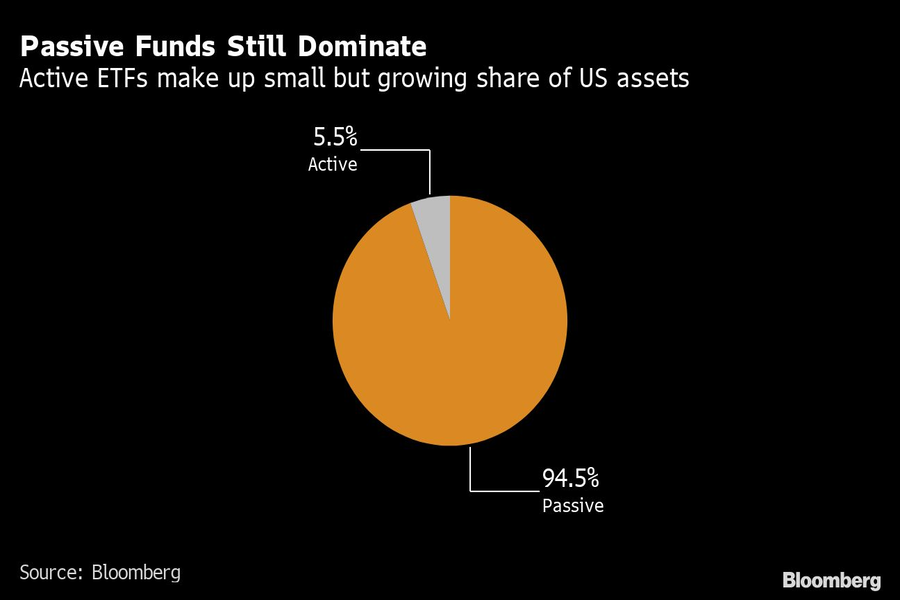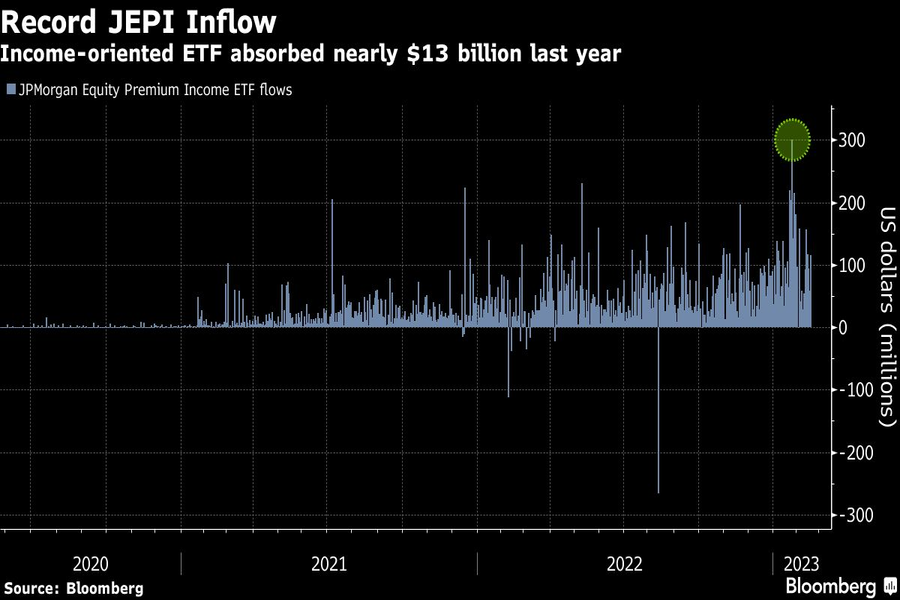

The world of exchange-traded funds — still synonymous with passive investing — is turning into a battleground for Wall Street’s biggest players as they compete for a slice of the active-management industry.
Active products have scooped up almost a third of the $49 billion flooding into ETFs this year, as stock pickers take on new luster in an era of Federal Reserve policy tightening and investors funneling cash ever more into tax-efficient vehicles. That’s a record share of flows, though it’s still just 6% of the $7 trillion market by assets.
The deluge of new cash is kicking off an arms race of sorts among issuers. With the likes of BlackRock Inc. and Vanguard Group largely controlling the passive market thanks to virtually zero-cost S&P 500 funds, firms such as JPMorgan Chase & Co. and Dimensional Fund Advisors are locking horns at the top of the active leaderboard.
And the arrival of Morgan Stanley’s first ETFs this month is upping the ante.
“We are laser-focused on active management. That’s our core competency, that’s what we do at Morgan Stanley Investment Management,” Anthony Rochte, Morgan Stanley’s global head of ETFs, said in a Bloomberg Television interview. “Longer-term, you can expect to see more active from us. I’m not sure we’re going to go to almost zero with the passive ETFs.”

Those are fighting words from the Wall Street giant, which commands about $5.5 trillion of assets across its wealth and investment management divisions — including hundreds of billions in existing ETFs. The potential that Morgan Stanley might eventually redeploy some of those assets to its own funds makes it a clear threat to the current leaders of the active ETF business.
JPMorgan Asset Management’s Bryon Lake projects that active ETFs in the U.S. will grow almost eightfold over the next five years to $3 trillion from $384 billion currently, with the ETF industry overall more than doubling to $15 trillion.
“Active delivered through the ETF wrapper, we think, is really going to be important,” Lake, global head of ETF solutions, said on Bloomberg Television’s ETF IQ. “Up to $3 trillion in the next five years could be in active.”
Active ETFs are booming as investors shun often pricier, slower to trade mutual funds for the easier-to-access structure. At the same time, rule changes in 2019 made it far simpler for managers to bring active funds to market, while the likes of Cathie Wood demonstrated the potential depth of investor appetite.
Meanwhile, the Fed’s historically aggressive tightening campaign unleashed volatility across asset classes last year, boosting the appeal of active strategies as they delivered strong performance. Some 62% of active large-cap so-called core funds outperformed the S&P 500 in 2022, the highest percentage since 2005.
Morgan Stanley faces stiff competition. Currently, JPMorgan controls the two largest active ETFs on the market: the $24.4 billion JPMorgan Ultra-Short Income ETF (JPST) and the $21 billion JPMorgan Equity Premium Income ETF (JEPI).
Both funds absorbed record inflows last year as the Fed’s quest to quell endless inflation shredded returns across asset classes, boosting the allure of steady income streams delivered by both products. JEPI attracted nearly $13 billion, shattering the high watermark for active ETF flows set by Wood’s Ark Innovation ETF (ARKK).
Though JPMorgan boasts the biggest actively managed products, quant giant Dimensional holds the crown for largest active ETF issuer. The Austin, Texas-based manager controls roughly $82 billion across its lineup of 30 funds, less than three years after its first ETF began trading.

Dimensional’s growth was turbocharged by converting billions of dollars’ worth of its mutual fund assets into ETFs, a path taken by about 40 issuers so far. While it generally means a hit to fee income — ETFs usually charge less than mutual funds — the gamble is that it will help retain clients and attract new ones. Meanwhile, active ETFs are so far managing to charge an average 68 basis-point fee, versus 47 basis points for passive funds.
Flipping mutual-fund assets to an ETF hasn’t always proved a recipe for success, but the quant behemoth has seen significant positive net inflows since converting.
As the competition for active ETF dominance heats up, Lara Crigger at data-provider and research firm VettaFi expects more firms to attempt conversions and more big flows into active ETFs.
“I think we’re going to see a lot of flows going into these issuers that can bring their own assets to the table,” Crigger said on Bloomberg Television’s ETF IQ. “If anybody can do it, it would be Morgan Stanley.”

The looming threat of federal funding cuts to state and local governments has lawmakers weighing a levy that was phased out in 1981.

The fintech firms' new tools and integrations address pain points in overseeing investment lineups, account monitoring, and more.

Canadian stocks are on a roll in 2025 as the country prepares to name a new Prime Minister.

Carson is expanding one of its relationships in Florida while Lido Advisors adds an $870 million practice in Silicon Valley.

The approval of the pay proposal, which handsomely compensates its CEO and president, bolsters claims that big payouts are a must in the war to retain leadership.
RIAs face rising regulatory pressure in 2025. Forward-looking firms are responding with embedded technology, not more paperwork.
As inheritances are set to reshape client portfolios and next-gen heirs demand digital-first experiences, firms are retooling their wealth tech stacks and succession models in real time.
